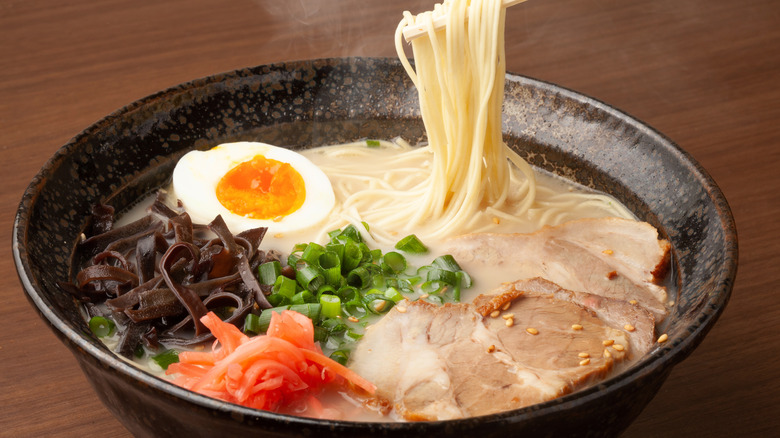Why You Should Prep The Pork In Advance When Making Homemade Tonkotsu Ramen
Homemade ramen is a labor of love, especially when making a traditional tonkotsu ramen. Getting the creamy white pork broth just right alongside tender slices of rolled pork chashu requires some patience and attention to detail, as well as a bit of a time commitment. Considering all the steps involved before you get to finally enjoy your bowl of ramen, it's quite sensible to do some of the steps ahead of time. Tasting Table's Leah Maroney suggests that prepping the pork belly chashu is one part of her tonkotsu ramen recipe best done in advance.
The tender rolled pork belly is sliced thinly to top the finished ramen, and Maroney says that the result "slices so much easier when chilled." Chilling allows the fatty portions of the pork to firm up after cooking, making them less likely to slip and slide while trying to make precise cuts. The rolled pork can also break apart when warm, according to Maroney, so having a well-cooled piece is essential for getting an attractive slice to float atop the bowl.
Pork belly chashu is worth the time
While it's true this version of ramen takes far more effort than your instant cup of noodles, the end result is so elevated it's hard to compare, especially when you add in the delicious slices of chashu. Leah Maroney suggests rolling a piece of pork belly into the traditional spiral shape, tying it together with kitchen twine. The roll is then oven-braised for several hours in an aromatic mixture of soy sauce, mirin, and hoisin sauce with ginger, garlic, and onions. While the moist heat transforms the pork belly into a fork-tender texture, the liquid gives the meat its characteristic salty-sweetness. Once you've tasted this savory slice of pork, you'll know why it was worth the time and effort. Maroney says when you're ready to serve a bowl of ramen, the slices can either be warmed up in the tonkotsu broth or by a quick pass under the broiler.
You can keep your chashu in the refrigerator well-wrapped for several days — assuming you don't eat it all first! Once you taste it, you'll want to add a bit to fried rice or maybe a morning omelet. The recipe not only provides you with tender chashu, but also the super-saturated flavor of the braising liquid, which is used to flavor the finished ramen bowl, but could also be saved to add depth to a pack of noodles when you don't have time for a full tonkotsu experience.

